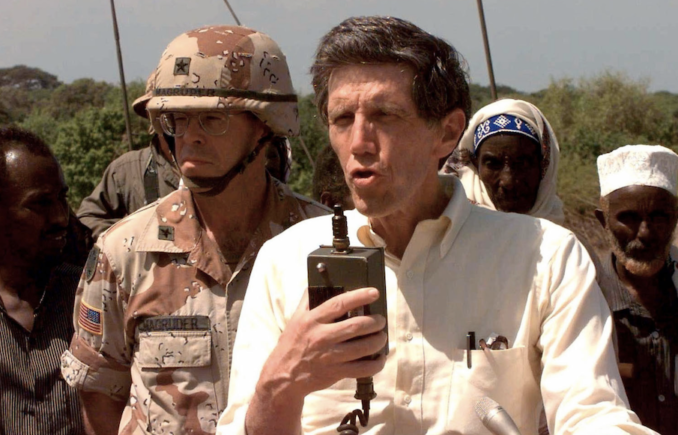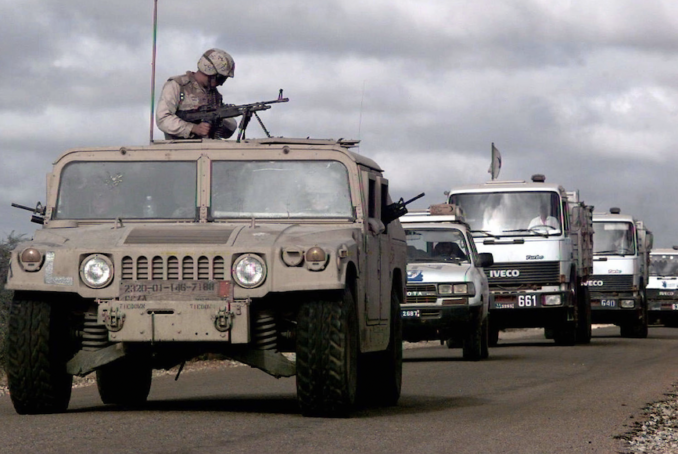Somalia is a land of great beauty and infinite
Promise… Tourists are assured and enjoyable
Stay in Somalia, where they will find the people
Friendly and the country attractive
“Beautiful Somalia”
Ministry of Information Booklet 1978
Upon landing on the beaches of Mogadishu on 9th December 1992, US commanders were on the roof of the airport building, giving live TV interviews explaining the “mission of mercy”. Have no doubt they said: witness the birth of the New World Order, the first purely benevolent use of the strongest army on the planet, the military might of the last superpower harnessed to feed people, to save innocent Somalis from the predations of warlords, to rescue a useless 3rd World nation in Africa from devouring itself.
George Bush declared the troops were doing “God’s work”, in Somalia, on a mission that Americans “cannot fail”.
Fresh after Iraq, the US military took the first steps into unchartered territory. Feeling invincible, this humanitarian mission was supposed to define the impulse of the New World Order. Even at the outset, there were indications of the disaster to come.
Relief agencies, hardest hit by Somalis, made the loudest call for military intervention. One aid manager stated, for the benefit of US TV news, “There should be a massive UN operation to disarm everyone, because it’s ridiculous that any 12-year-old boy with a gun can disrupt a multimillion-dollar relief operation.”
The number of famine deaths had peaked by November 1991 and were in decline when the US military arrived, largely because those most likely to die had already done so. Several lootings underscored the continuing insecurity. The UN and US State Dept officials promoted an unverified estimate of 80% losses due to gunmen. Boutros Ghali told the UN Security Council that Somalia was no longer, “Susceptible to the peacekeeping treatment.” He showed the UNSC the mountain of 14,000 MT of relief food piled up in Mogadishu airport as it was too dangerous to distribute.
The warnings to stay away remained strong. The US military’s gut instinct was to avoid complex clan feuds altogether, despite the urgent aid need. US Ambassador to Kenya [the last post holder posted with intelligence] Smith Hempstone, a former journalist who had travelled widely in Africa, foresaw a quagmire about to unfold and warned against, “Embracing the Somalia tar baby. Somalis were natural-born guerrillas, they will mine roads, they will launch hit-and-run attacks. They will not be able to stop convoys getting through. But they will inflict and take – casualties.” Referring to the 241 Marines killed in Lebanon in 1983 by a single suicide bomber unhappy with their presence, Hempstone cabled Washington, “If you liked Beruit, you’ll love Mogadishu.” State Dept ignored him.
The US invasion began at dawn. Amphibious vehicles rolled onto beaches and the first US Marines onto the airport. Fourteen unarmed Somali airport guards, wired to the moon on Qat, were arrested.
Nothing could have suited the US “invasion” of Somalia better than to be swamped with press coverage. While US troop commanders complained of press getting in the way of the mission, they were reminded that all press had been briefed 24 hours before on the landings by US envoy Robert Oakley as a “made for TV” event.
Operation Restore Hope Descends
George Bush’s “Special envoy” Robert Oakley, a retired former Ambassador to Somalia (1982-1984) and relic from the Cold War set to work. His first job was to ensure that the Marine landing did not occur in a hostile environment. The dismissal of UN envoy Mohamed Sahnoun in October had ended any chance of a carefully constructed peace deal.

Special Envoy to Somalia, Ambassador Robert Oakley,
PHCH Terry Mitchell – Public domain
Oakley made two decisions that would eventually turn the US-UN presence in Somalia into a debacle.
The first was that, instead of marginalizing the warlords, which Somalis expected, Oakley embraced them, seeking their support of US intervention. The second, far more critical and disastrous decision he [and cautious US commanders] made was to leave the warlord arsenals intact and to make no concerted attempt to disarm Somalia.
The majority of Somali goodwill to US intervention was strong, Aidid, Ali Mahdi welcomed it. As a result of Somali war weariness, the narrow Op Restore Hope window opened. The overwhelming majority of Somalis believed this was the chance to lessen the warlord influence. If done equitably among ALL clans, Somalis would have accepted disarmament nationally. However, within a few months, the window closed as US forces took sides against Aidid and his subclan.
Two days after US forces established the bridgehead, Oakley presided over a public rapprochement between the warlords.
Aidid and Ali Mahdi embraced and stated they had already agreed to peace among themselves to prevent their “loyalists” from harassing US troops and to dismantle the Green Line. The majority of Somalis were annoyed and saw a crucial dynamic. Oakley refused to meet other warlords, especially Mohamed Hersi Morgan, son-in-law of ousted President Barre. Oakley declared he was a cold-blooded murderer and massacred his own people. The US-brokered peace deal appeared to Somalis to also give an official seal of approval to the two warlords’ political status and roles.
But the quiet landing and peace deal came with a high price that smelt of betrayal. Oakley, having legitimized the warlords, to reach his peace agreement, allowed them to keep their weapons arsenals in cantonment sites outside the city. As long as US troops were not harmed, the arsenals remained intact. This decision not to disarm came as a shock to Somalis. Disarmament was part of the original mission statement but was dropped right before the executive order was issued, on the insistence of higher US military command. Oakley’s official position was, “We can’t disarm New York or Washington how could we disarm Mogadishu?”
However, without nationwide disarmament, Aidid and Ali Mahdi drew the obvious conclusion, the US may as well leave.

Along the road from Mogadishu to Biadoa,
National Archives at College Park – Public domain
The volte-face mission direction caused a row between Washington and Boutros Ghali, who publicly said Bush promised him disarmament. The “new US” stance fitted in with its ambitious timetable to start withdrawing troops as early as January, and its commitment to zero casualties, an approach influenced by lack of conviction behind a Lame stream intervention.
Oakley probably did not need to plan ahead due to a mixture of motives. Bush in his twilight as president wanted to tick a positive box, as well as reportedly affected by images of starving kids. Bush’s “policymakers” envisioned a limited salvation army role, which led to their anomaly of immaculate intervention, which they considered above local “politician warlords” – an error of mega dimensions. For Bush, having created the problem with no real solution in the former Yugoslavia, it also allowed him to avoid being sucked into the European quagmire of Bosnia. For the UN, the primary reason for massive intervention in Somalia was because Boutros Ghali thought it would be a suitable cover for the UN’s mammoth failures and delays in dealing with a crisis at all.
Oakley later admitted postponing disarmament created difficulties for the subsequent UNOSOM II mission. The little-remarked example of Pakistani UNOSOM I troops helped shape Oakley’s thinking. Their arrival was carefully negotiated by former UN envoy Sahnoun and approved by both warlords. Aidid halted their deployment.
Hamstrung by UN rules requiring consent of all parties, the troops remained idle south of Mogadishu for six weeks.
In Mogadishu, the peaceful glow of arrival dimmed as quickly but more seriously. A Marine patrol inspected a building opposite the US Embassy. They caught Somalis with an array of technicals and an arms cache belonging to Osman Ato under canvas. The Somalis were arrested. Osman arrived, the patrol leader radioed for instructions and was ordered to release the arrested and hand arms back to the rightful owner. Ato as well as Aidid and Ali Mahdi determined they were indeed untouchable.
The limited US mandate and steady political pressure on newly elected Clinton to bring troops home meant the mission would be handed over under UN control. The handover was set for Feb 1993 but the UN was slow to organize and it slipped to May. Aidid had bet on US success and managed to separate good from bad – US from UN – in his supporters’ minds.
Bush visited Mogadishu and Baidoa on New Year’s Day. Boutros Ghali’s visit on 4th January was different. Prompted by Aidid’s rhetoric, there were riots outside the UN offices, with one Somali replacing the UN flag with a Somali one. Under a barrage of chants of “UN neo-colonialism” Boutros Ghali was forced to flee by helicopter, cutting his day visit to two hours.
Aidid’s goodwill to the US also began to unravel. Omar Jess, Kismayo warlord and Aidid ally was ousted under the unsuspecting noses of Belgian and US troops by General Hersi Morgan whose troops disguised as shepherds and farmers, entered overnight and took Kismayo without a shot fired. Aidid blamed foreign troops for taking sides and organised riots in Mogadishu. This coincided with the Oakley-Ato confrontation. Ato complained UNITAF were only confiscating his group’s arms, making the Somali National Alliance vulnerable. Without redress Ato stated protests would begin, Oakley laughed, the next day, riots began.
The US, were unable or unwilling to stop the unrest, within hours it was clear Aidid still had firm control. He no longer trusted the US or UN “neutrality” and was prepared to fight back. The disarmament window firmly closed, the US and UN were drawn into Somalia’s political game.
After this turnaround, the US expedited arrangements to hand over the mission to the UN. When the UN finally did take over, it had one-third of its admin staff in place. The “New World Order” mission mandate was the most ambitious pie in the sky ever – “nation building”.
The mandate included total, national forced disarmament – which the US had shied away from. Helping form the creation of a new government, rebuilding Somalia’s economy and a “UN” financed and trained police force and justice system. Everything from schools, to water and electricity to phone systems were to be rebuilt. The expanded mission called UNOSOM II was one of “peace enforcement” not peacekeeping, in which warlords would be compelled to disarm or be eliminated.
The overarching problem despite US intervention, what split Somalia in the first place, were still there and well-armed. Before the handover to the UN, the Green Line was quiet. When UN troops took over in May 1993, they expected to be tested, and were not disappointed.
© AW Kamau 2023



